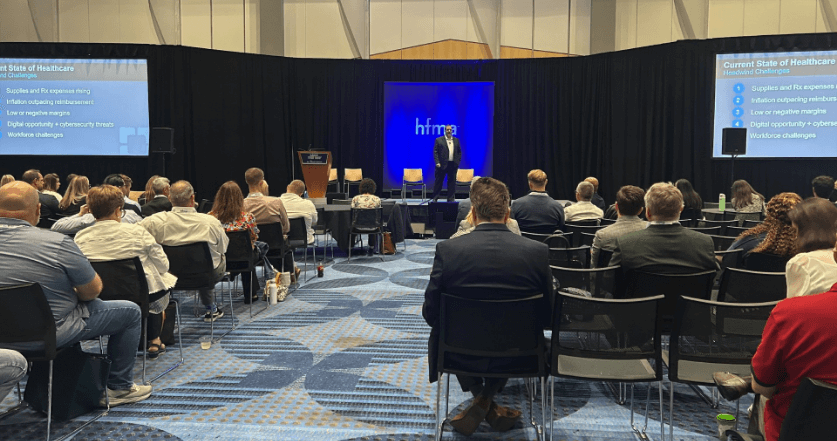

Stop Paying the “Wedding Premium”
Tap Into Indirect Procurement Expertise from Outside of Healthcare
I had the pleasure of attending a presentation at the HFMA Annual meeting delivered by John Dockins, Executive Director of Sourcing & Vendor Management at the Cleveland Clinic. Dockins’ informative, edgy, and entertaining presentation chronicled the Clinic’s 20-year journey in managing indirect (non-clinical) spend. In this blog, I share the background on the Clinic’s journey and several of the key messages that John offered in his presentation.
Cleveland Clinic is a name to be reckoned with when it comes to all things supply chain. In addition to being internationally recognized for clinical excellence, its supply chain is one of the best in the industry. To wit, Gartner awarded the Clinic’s supply chain its exclusive “Master” status, a designation only afforded to two other healthcare organizations, in 2024.
The Clinic first ventured into indirect procurement in 2006, focusing on what Dockins identified as “low-hanging fruit.” Their efforts took on more significance in 2010, as the organization embarked on an enterprise-wide cost reduction effort. Dockins described a process where, one by one, procurement leaders were asked to write their supply spend on a whiteboard. The person responsible for clinical supply spend wrote “$1B.” The person responsible for pharmacy spend followed suit, adding another “$1 billion” to the list. Next was Dockins’ turn, who theoretically managed all indirect spend across the Clinic.
Dockins admitted that he didn’t know for certain, since their systems didn’t track indirect spending very well. However, he said he can do basic math. Since he knew that the Clinic spent $3 billion overall on goods and services, the “missing” $1 billion must have been spent on indirect items. He just could not say on what, with whom, at what price or, most critically, if it was under contract.
Dockins first big leap came in 2016, when he successfully brought all of IT spend under the management of his procurement team. With only two people at the time, Dockins partnered with the Clinic’s CIO to assume responsibility for IT contracting and procurement, including responsibility for the cost savings bogey that had been thrust on the CIO. It proved an overwhelming task for just two people, and Dockins playfully demonstrated that their efforts largely “kicked (the can) down the road”.
Over time, Dockins and his team established credibility with the IT business owners, along with the business owners of other indirect spending (corporate services, marketing, facilities, and construction, etc.), assuming increasing responsibility and control for a greater share of the indirect spend. Dockins’ team grew to 20-25 procurement specialists, all devoted to indirect spend.
Even with 20 years under their belt and 20-25 people working on the problem, a headcount that most supply chain leaders can only dream to employ, Dockins still isn’t satisfied.
In 2023, Dockins marshalled a shift in how the organization considered its role in indirect procurement. First, he became increasingly convinced that contract negotiators are first and foremost risk mitigators for the organization. The pandemic, port disruption, the Baxter IV problem were but a few examples of how risk mitigation became central to supply chain resiliency, and it all starts with the contract negotiation process.
Dockins also struggled with knowing if he was getting the best price for the indirect services he and his team were procuring. “He knew what he was paying but wasn’t sure if it was a good price or not. According to Dockins, the problem then and now is that indirect services can’t be reduced to a simple item master unit price. Benchmarks were ineffective, if available at all.
With a clear criticism of the industry, he believes that most would agree that healthcare is not an efficient standard when it comes to purchasing benchmarks. The Clinic continued to compare themselves to others in the industry and realized that being the best among a low standard is not effective. Dockins wanted to know how the Clinic compared outside the industry. The Clinic approached leading companies outside of healthcare to learn how they performed and how the Clinic, strong by healthcare standards, stood against non-healthcare organizations. He didn’t always like the answer, but wasn’t afraid to set a higher standard.
Reaching a partnership with LogicSource, Dockins learned the good and bad news. While the Clinic’s 20-year journey and large dedicated team yielded good results in many categories, LogicSource helped him see where his team fell short of what companies were achieving outside the industry. To him, “elevator maintenance is elevator maintenance and landscaping services are landscaping services,” whether for healthcare, retail, or consumer packaged goods. He said that the industry must stop saying healthcare is different, which is simply an excuse for underperformance and an invitation for suppliers to charge more.
An audience member at the conference referred to this as the “wedding premium,” like the photographer costs more when it’s for a wedding (who is going to argue when it’s your son or daughter’s wedding?), healthcare seemingly pays more for the same things that retail organizations buy.
Health systems spend 20-25% of their revenue, and at times over 30%, on indirect goods and services. Yet, they devote substantially less resources, have limited benchmarks, and don’t exert the same central control over this spending that they devote to clinical spending. (Next time you argue with a physician about the need to reduce device prices, try and defend why you aren’t managing indirect spending as aggressively.)
Dockins cited statistics that a well-oiled indirect spending infrastructure could improve a health system’s operating margin by 200-300 basis points.
He offered perhaps his edgiest perspective, explaining that if he did it all over again, he would go about it differently. Instead of building his indirect procurement capability internally, he would have partnered from the start with an execution-based organization with experience in and outside of healthcare, which is exactly what he is doing now. Dockins said most healthcare organizations are significantly undercommitted and under-resourced to manage indirect spend properly. He challenged the audience with the question, “Build it or buy it?” However, he cautioned attendees, “If you elect to build it, I will see you in 20 years, because that’s how long it’s taken us.”
Can you afford to take that long? Can you afford to forgo a potential 200-300 basis point operating margin improvement?
Looking for a partner to help with your non-clinical sourcing and procurement needs? Get in touch with us, and we’ll walk you through the process.






